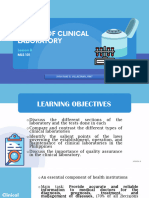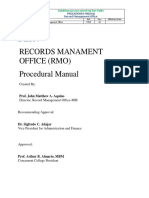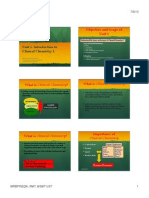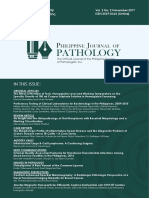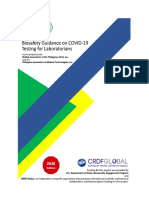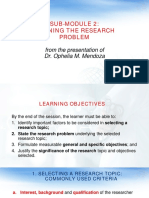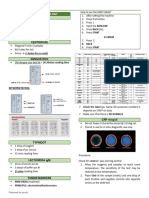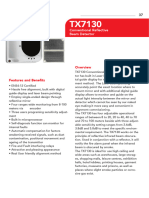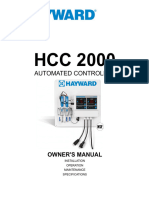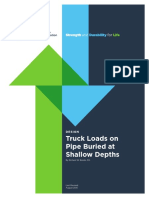PMLS 2 Unit 4
PMLS 2 Unit 4
Uploaded by
Elyon Jirehel AlvarezCopyright:
Available Formats
PMLS 2 Unit 4
PMLS 2 Unit 4
Uploaded by
Elyon Jirehel AlvarezOriginal Description:
Copyright
Available Formats
Share this document
Did you find this document useful?
Is this content inappropriate?
Copyright:
Available Formats
PMLS 2 Unit 4
PMLS 2 Unit 4
Uploaded by
Elyon Jirehel AlvarezCopyright:
Available Formats
PRINCIPLES OF MEDICAL LABORATORY SCIENCE 2
College of Allied Health Sciences
Bachelor of Science in Medical Laboratory Science
Second Semester, A.Y. 2022-2023
[TRANS] PMLS UNIT 4: BLOOD COLLECTION EQUIPMENT AND SUPPLIES, ADDITIVES AND ORDER OF DRAW
o Povidone-iodine(0.1%-1% available
OUTLINE iodine)
o Tincture of Iodine
I Blood Collection Equipment Disinfectants
II Tube Additives - chemical substances regulated by the
III Order of Draw Environmental Protection Agency (EPA)
- are used to remove or kill microorganisms on
surfaces and instruments
- are corrosive and are not safe to use on human
BLOOD COLLECTION EQUIPMENT skin
- EPA-registered sodium hypochlorite products are
BLOOD-DRAWING STATION preferred
Blood Drawing Station o solutions made from generic 5.25%
o A dedicated area of a clinical laboratory equipped sodium hypochlorite (household bleach)
for performing phlebotomy procedures on patients, may be used
primarily outpatients sent by their physicians for o 1:100 → nonporous surfaces after
laboratory testing. cleaning up blood or other body fluid
o Phlebotomy Chair spills
o 1:10 → is applied prior to cleanup when
spills involve large amounts of blood or
other body fluids
o At least 10 minutes of contact time
Hand Sanitizers
- CDC/HICPAC recommends the use of alcohol-
based hand sanitizers for routine
decontamination of hands (when hands are not
visibly soiled).
- detergent-containing wipes followed by the use
of an alcohol-based hand cleanser → if hands are
heavily contaminated with organic material
and hand-washing facilities are not available
Gauze Pads/Cotton Balls
- Clean 2-by 2-inch gauze pads folded in fourths
are used to hold pressure over the site following
Equipment Carriers blood collection procedures
o Handheld Carrier (Phleb Kit) - Use of cotton balls to hold pressure is not
o Phlebotomy Cart recommended
BLOOD COLLECTION EQUIPMENT Bandages
Gloves - Are used to cover a blood collection site after the
- The CDC/HICPAC standard precautions and bleeding has stopped
OSHA require the wearing of gloves when - CAUTION: Adhesive bandages should not be
performing phlebotomy. used on babies younger than 2 years of age
- A new pair must be used for each patient and be because of the danger of aspiration and
removed when the procedure is completed. suffocation.
- Nonsterile, disposable latex, nitrile, neoprene, Needle and Sharps Disposal Containers
polyethylene, and vinyl examination gloves - sharp objects must be disposed of immediately in
Antiseptics special containers referred to as “sharps”
- Substances used to prevent or inhibit the containers
growth and development of microorganisms but Biohazard Bags
do not necessarily kill them - leakproof plastic bags that are commonly used
- Safe to use on human skin and are used to clean to transport blood and other specimens from the
the venipuncture site collection site to the laboratory
- most commonly used: 70% isopropyl alcohol Slides
(isopropanol) - Precleaned 25- by 75-mm (1- by 3-in.) glass
o Benzalkonium chloride (Zephiran microscope slides
chloride, 1:750) o are used to make blood films for
o 70% isopropyl alcohol followed by an hematology determinations
iodophor o either plain or with a frosted area at one
o Chlorhexidine gluconate end
o 70% Ethyl Alcohol Pen
o Chlorhexidine gluconate - A phlebotomist should always carry a pen with
o Hydrogen Peroxide indelible (permanent) nonsmear ink to label tubes
and record other patient information.
FORGER, ANYA| CECILE HALL 1
TRANS: PMLS 2 Unit 4
Watch 20 Multisample Sometimes used when
- A watch, preferably with a sweep second hand or Hypodermic large-volume tubes are
timer, is needed to accurately determine collected or large-
specimen collection times and time certain volume syringes are
tests. used on patients with
VENIPUNCTURE EQUIPMENT normal-size veins
Evacuated Tube System (ETS) – most preferred 21 Multisample Considered the
Syringe System – used on small, fragile and damaged Hypodermic standard
veins venipuncture needle
Butterfly System – can be used with the ETS and syringe. for routine
It is used to draw blood from infants and children’s hand venipuncture on
veins and other difficult-draw situations patients with normal-
VEIN LOCATING DEVICES size veins
Vein-Locating Devices – transillumination devices that 22 Multisample Used on older children
make it easier to locate veins that are difficult to see or feel Hypodermic and adult patients with
Tourniquet – A device that is applied or tied around a small veins or for
patient’s arm prior to venipuncture to restrict blood flow syringe draws on
difficult veins
o Strap Tourniquet – most common type; is a flat
strip of stretchable material, such as latex, nitrile, or 23 Butterfly Used on the veins of
vinyl that is fairly inexpensive and disposable infant and children and
o 1 minute Application on difficult or hand
veins of adults
NEEDLES
Multisampel Needles – needle color codes vary among
Needles – are sterile, disposable, and designed for a
manufacturers; however, several large manufacturers use:
single use only
o Yellow for 20-gauge
o Multisample needles – allows collection of multiple
o Green for 21-gauge
tubes during venipuncture
o Black for 22-gauge
o Hypodermic needles – used for patients with veins
from which it is difficult to collect blood and for Tube Holder – plastic cylinder with a small opening for a
blood gas analysis. needle at one end and a large opening for tubes at the other
o Winged infusion (butterfly) needles – an end
indispensable tool for collecting blood from small or o OSHA regulations require that the tube holder with
difficult veins such as hand veins and veins of needle attached be disposed of as a unit after use
elderly and pediatric patients as it allows much more and never be removed from the needle and reused.
flexibility and precision than a needle and syringe. o A needle or tube holder that has a safety device is
an example of a SESIP, which is the OSHA acronym
PARTS OF A NEEDLE
for a sharp with engineered sharps injury
Bevel – the end that pierces the vein, it is “beveled,” or
protection.
cut on a slant
EVACUATED TUBES
o The bevel is the slanted opening at the end of the
needle. Evacuated Tubes
o Bevel of the needle must face upward when the - Designed to fill with a predetermined volume of
needle is inserted into the vein. blood by vacuum
- Rubber stoppers (color coded according to
Shaft – the long cylindrical portion
additive content)
Hub – the end that attaches to the blood collection
o Premature Loss of Vacuum → PARTIAL DRAW
device
OR SHORT DRAW:
Bore/Lumen – internal space of the needle
Improper storage
NEEDLE GAUGE Opening the tube
Needle Gauge – indicated by a number that is related to Dropping the tube
the diameter of the lumen Advancing the tube too far onto the needle
o the higher the gauge number, the smaller the before venipuncture
actual diameter of the needle If the needle bevel becomes partially out of
o 21 G – standard for venipuncture the skin during venipuncture
o 23 G – for children; small and difficult veins Stoppers
o 25 G – used by specially trained personnel to collect - Also known as tops or closures
blood from the scalp or other tiny veins of - Are made up of rubber
premature infants and neonates - Some tubes have a rubber stopper covered by a
Gauge Needle Type Typical Use plastic shield
15-17 Special needle Collection of donor Stopper Color Additive Department(s)
attached to collection units, autologous blood Light Blue Sodium Coagulation
bag donation, and Citrate
therapeutic phlebotomy Red None Chemistry, Blood Bank,
18 Hypodermic Used primarily as a Serology/Immunology
transfer needle rather Red Clot Activator Chemistry
than for blood Red/Light None NA (Discard Tube only)
collection; safety Gray
tissues have diminished
Clear
use
FORGER, ANYA| CECILE HALL 2
TRANS: PMLS 2 Unit 4
Red/Black Clot Activator Chemistry CLSI recommends spray-dried EDTA for most hematology
(Tiger) and Gel tests
Gold Separator
Red/Gold KEY POINT: Excess EDTA, which results when tubes are
Green/Gray Lithium Chemistry underfilled, can cause RBCs to shrink and thus change
Light Green Heparin and CBC results!
Gel Separator CITRATES
Green Lithium Chemistry Prevent coagulation by binding or chelating calcium
Heparin Most common citrate is sodium citrate, which is used for
Sodium coagulation tests
Heparin Sodium citrate tubes have light-blue stoppers (B:A = 9:1)
Ammonium Sodium citrate – also used in special Erythrocyte
Heparin Sedimentation Rate (ESR) tubes with black stoppers
Lavender EDTA Hematology (B:A = 4:1)
(Purple) 3-4 gentle inversions are required for adequate mixing
Pink EDTA Blood Bank HEPARIN
Gray Sodium Chemistry Prevents clotting by inhibiting thrombin formation
fluoride and Heparinized plasma is often used for some chemistry
potassium tests, especially stat tests (e.g., electrolytes)
oxalate
Heparin is the additive in:
Sodium
o Green-top tubes
fluoride and
o Green-top and light green–top gel tubes
EDTA
o Mottled-green and gray-top tubes
Sodium
o Royal blue–top tubes with green color coding on
fluoride
the label
Orange Thrombin Chemistry o Green-top and light green–top microcollection
Gray/Yellow tubes
Royal Blue None Chemistry o Red-banded and green-banded microhematocrit
EDTA tubes
Sodium Three heparin formulations:
heparin o Ammonium
Tan EDTA o Lithium
Yellow Sodium Microbiology o Sodium heparin
polyanethol 5-10 inversions
sulfonate
OXALATE
(SPS)
Prevents coagulation by precipitating calcium
Yellow Acid citrate Blood
dextrose Bank/Immunohematology Potassium oxalate is the most widely used
(ACD) It is commonly added to tubes containing glucose
preservatives to provide plasma for glucose testing
Potassium oxalate is the additive in:
BLOOD COLLECTION EQUIPMENT
o Gray-top evacuated tubes and
o Microcollection containers with gray tops
ANTICOAGULANTS
8-10 inversions are required for proper mixing
Anticoagulants – substances that prevent blood from
SPECIAL USE ANTICOAGULANTS
clotting (coagulating) by either of two methods
o by chelating (binding) or precipitating calcium Acid-Citrate Dextrose(ACD)
o by inhibiting the formation of thrombin o ACD solution is available in two formulations
(solution A and solution B) for
Specimen – whole blood or Plasma
immunohematology tests such as DNA testing and
human leukocyte antigen (HLA) phenotyping, which
EDTA (ETHYLENEDIAMINETETRAACETIC ACID) is used in paternity evaluation and to determine
Commonly available as a powdered K2EDTA or liquid transplant compatibility.
K3EDTA The acid citrate prevents coagulation by
Prevents coagulation by binding or chelating calcium binding calcium.
EDTA is the additive in: Dextrose acts as a RBC nutrient and
o Lavender (purple)-top tubes preservative by maintaining RBC viability.
o Microcollection containers with lavender tops o ACD tubes have yellow tops and require 8
o Pink plastic-top tubes with a special blood bank inversions immediately after collection to prevent
patient ID label clotting
o Pearl-top tubes with thixotropic gel separator Citrate Phosphate Dextrose (CPD)
o Royal blue–top tubes with lavender color-coding o used in collecting units of blood for transfusion
on the label Citrate prevents clotting by chelating
Provide whole-blood specimens for hematology tests calcium
8-10 inversions are normally required for proper mixing Phosphate stabilizes pH
Caution: If microclots are detected in a hematology Dextrose provides cells with energy and
specimen, it cannot be used for testing and must be helps keep them alive
recollected. Sodium Polyanethol Sulfonate (SPS)
FORGER, ANYA| CECILE HALL 3
TRANS: PMLS 2 Unit 4
o Prevents coagulation by binding calcium 2. Blue-top coagulation tube
o Used for blood culture collection 3. Serum tube with or without clot activator, with or
o It also reduces the action of a protein called without gel
complement, which destroys bacteria 4. Heparin tube with or without gel plasma
o Yellow stoppers separator
o Requires 8 inversions to prevent clotting 5. EDTA tube
6. Glycolytic inhibitor tube
ANTIGLYCOLYTIC AGENTS
Antiglycolytic Agents STOP, LIGHT RED, STAY PUT, GREEN LIGHT, GO
o A substance that prevents glycolysis
o Sodium fluoride - most common antiglycolytic
agent
o Glucose is metabolized at RT at a rate of 7
mg/dL/hour and at 4˚C, glucose decreases by
approximately 2 mg/dL/hour.
o Preserves glucose for up to 3 days and also inhibits
the growth of bacteria
o Gray stoppers
o Requires 5-10 inversions
CLOT ACTIVATORS
Clot Activators
o are used to collect serum specimens
o include substances such as glass (silica) particles
and inert clays like Celite, and clotting factors
such as thrombin
o Silica particles – are the clot activators in
serumseparator tubes (SSTs) and plastic red-top
tubes; cause the blood to clot within 15 to 30
minutes
o Thrombin tubes - clot within 5 minutes
o Require 5 gentle inversions
THIXOTROPIC GEL SEPARATOR
Thixotropic Gel Separator
o An inert (nonreacting) synthetic substance
initially contained in or near the bottom of certain
blood collection tubes
o Serum gel-barrier tubes are called serum-separator
tubes (SSTs)
o Heparinized plasma gel-barrier tubes are called
plasma-separator tubes (PSTs).
TRACE ELEMENT-FREE TUBES
Trace Element-Free Tubes
o Have royal-blue stoppers
o Are made of materials that are as free of trace
element contamination as possible
o They are used for trace element tests, toxicology
studies, and nutrient determinations
o Royal blue–top tubes contain EDTA, heparin, or no
additive to meet various test requirements
ORDER OF DRAW
Order of Draw
o Refers to the order in which tubes are collected
during a multiple-tube draw or are filled from a
syringe
o A special sequence of tube collection that reduces
the risk of specimen contamination by
microorganisms
Additive Carry Over
o Affects chemistry test
o Occurs when blood in an additive tube touches
the needle during venipuncture or during transfer
from a syringe
CLSI RECOMMENDED ORDER OF DRAW
CLSI recommends the following order of draw:
1. Sterile tube (blood culture)
FORGER, ANYA| CECILE HALL 4
You might also like
- Lesson 8Document48 pagesLesson 8Xigna Milano AmoresNo ratings yet
- Semen and Sperm Analysis 02-27-2015Document9 pagesSemen and Sperm Analysis 02-27-2015Yuanda KhanNo ratings yet
- Mapeh Grade 8: Quarter 1 Week 1 Module 1Document37 pagesMapeh Grade 8: Quarter 1 Week 1 Module 1Bayoyong Nhs100% (2)
- Dilution CalculatorDocument7 pagesDilution CalculatorModiGopiNo ratings yet
- RMO ManualDocument34 pagesRMO ManualJohn Matthew AquinoNo ratings yet
- Lesson 2 Tissues (Human Anatomy and Physiology)Document53 pagesLesson 2 Tissues (Human Anatomy and Physiology)Dump Acc 2No ratings yet
- Workshop 1 (GROUP 1) : Profile of Laboratory Objectives of Laboratory Action Plan List of Non-CompliancesDocument32 pagesWorkshop 1 (GROUP 1) : Profile of Laboratory Objectives of Laboratory Action Plan List of Non-CompliancesGretchel PontilarNo ratings yet
- Module # 2 Medical Terminologies and Abbreviations and Ethics in The ProfessionDocument6 pagesModule # 2 Medical Terminologies and Abbreviations and Ethics in The ProfessionJonice NavarroNo ratings yet
- QOPMDocument2 pagesQOPMJaidee Sanchez100% (1)
- Basic Principles and PracticesDocument83 pagesBasic Principles and Practicesmeme bolongonNo ratings yet
- BBTS Tool 32nd EditionDocument62 pagesBBTS Tool 32nd EditionMostafa Ragab MohammadNo ratings yet
- Blood Collection: Routine Venipuncture and Specimen HandlingDocument17 pagesBlood Collection: Routine Venipuncture and Specimen HandlingLovely B. AlipatNo ratings yet
- Orientation To Clinical Biochemistry-PreanalyticalDocument6 pagesOrientation To Clinical Biochemistry-PreanalyticalasjxhiBBniu01j2No ratings yet
- Intro, Lab Math, and SafetyDocument15 pagesIntro, Lab Math, and SafetyJangHanbyul100% (1)
- Introduction To Biostatistics - Research Etymology: Notes From The Lecture & OrientationsDocument2 pagesIntroduction To Biostatistics - Research Etymology: Notes From The Lecture & OrientationsAngelo BautistaNo ratings yet
- Module6 Forensic ToxicologyDocument1 pageModule6 Forensic ToxicologyKUYA JM PAIRESNo ratings yet
- QA03005 Critical Testand Critical Result ReportingDocument7 pagesQA03005 Critical Testand Critical Result Reportingdebbie o. azcunaNo ratings yet
- Week 1 Pmls2Document45 pagesWeek 1 Pmls2Dayledaniel SorvetoNo ratings yet
- Health Statistics and EpidemiologyDocument15 pagesHealth Statistics and EpidemiologyDaniela Nicole Manibog ValentinoNo ratings yet
- 5527 and AmendmentsDocument18 pages5527 and AmendmentsMica BernardoNo ratings yet
- 1 Hema LecDocument5 pages1 Hema LecAngela ReyesNo ratings yet
- Eapp PPPTDocument3 pagesEapp PPPTALCAZAR, RENZ JAZTINE R.No ratings yet
- Guidelines For The Conduct of The Oral Revalida For Clinical Clerks (Batch 2020)Document2 pagesGuidelines For The Conduct of The Oral Revalida For Clinical Clerks (Batch 2020)mhegan07No ratings yet
- Special Collections and Point of Care TestingDocument42 pagesSpecial Collections and Point of Care Testingmicah cajandabNo ratings yet
- 2017b PDFDocument1,241 pages2017b PDFArizaldo Enriquez CastroNo ratings yet
- Handbook of Specimen Collection and Handling in MicrobiologyDocument72 pagesHandbook of Specimen Collection and Handling in MicrobiologyMiguel MataNo ratings yet
- M6 Histopath ImpregantionAndEmbeddingDocument4 pagesM6 Histopath ImpregantionAndEmbeddingninaNo ratings yet
- FCPS-II Haematology Prospectus 2023Document71 pagesFCPS-II Haematology Prospectus 2023regata4No ratings yet
- Medical Technology (MT) Laws: A. Basic ConceptsDocument19 pagesMedical Technology (MT) Laws: A. Basic ConceptsK-idol LiveNo ratings yet
- BSF Policy - RetentionDocument2 pagesBSF Policy - RetentionDarren CariñoNo ratings yet
- Safety Security Biosafety Laboratory Biosecurity PerspectiveDocument5 pagesSafety Security Biosafety Laboratory Biosecurity PerspectiveZabdiel Ann SavellanoNo ratings yet
- BRAP PAMET Biosafety Guidance On COVID 19 Testing For Laboratorians EDocument179 pagesBRAP PAMET Biosafety Guidance On COVID 19 Testing For Laboratorians EMM ReyesNo ratings yet
- PMLS Lesson 7Document2 pagesPMLS Lesson 7Althea EspirituNo ratings yet
- Submodule 2Document35 pagesSubmodule 2Sophia AngNo ratings yet
- Buenviaje-HEAT AND ACETIC ACID TESTDocument7 pagesBuenviaje-HEAT AND ACETIC ACID TESTrio salvadorNo ratings yet
- Chapter 04: Laboratory Safety Test Bank: 1. A. B. C. D. Ans: ADocument7 pagesChapter 04: Laboratory Safety Test Bank: 1. A. B. C. D. Ans: AroeNo ratings yet
- EpidemiologyDocument7 pagesEpidemiologykaren dapalNo ratings yet
- Clinical Chemistry 1 (MKEB2404)Document10 pagesClinical Chemistry 1 (MKEB2404)kiedd_04100% (3)
- FORSC 3B - Activity 1Document3 pagesFORSC 3B - Activity 1Joe Francis Dela PeñaNo ratings yet
- Immunology SerologyDocument3 pagesImmunology SerologySamanthaCadaDevillaNo ratings yet
- SF 66 Management Review TemplateDocument2 pagesSF 66 Management Review Templatefikyad93No ratings yet
- Patient'S Rights and Responsibilities: Dr. Eutiquio Ll. Atanacio Jr. Memorial Hospital IncDocument8 pagesPatient'S Rights and Responsibilities: Dr. Eutiquio Ll. Atanacio Jr. Memorial Hospital IncJoeren GonzalesNo ratings yet
- Tissue Processing For TEM: Fixation, Rinsing, Dehydration and EmbeddingDocument30 pagesTissue Processing For TEM: Fixation, Rinsing, Dehydration and EmbeddingBhaskar Ganguly100% (1)
- 8-Chapter 3 Text 2011Document50 pages8-Chapter 3 Text 2011medievoloNo ratings yet
- TSH, FT4, FT3, T4, T3, T-Uptake, FT4-Index, Anti-TPO, Anti-Tg, Anti-TSHR, TG, HCT Cobas e AnalyzersDocument28 pagesTSH, FT4, FT3, T4, T3, T-Uptake, FT4-Index, Anti-TPO, Anti-Tg, Anti-TSHR, TG, HCT Cobas e AnalyzersViktarNo ratings yet
- Clinical ChemistryDocument28 pagesClinical ChemistryRezzy Mae Panadero OraNo ratings yet
- CalciumDocument1 pageCalciumDinesh SreedharanNo ratings yet
- Risk Group and Biosafety Level Containment TableDocument3 pagesRisk Group and Biosafety Level Containment Tablesyznx100% (1)
- Lesson 3 Rules and RegulationsDocument5 pagesLesson 3 Rules and RegulationsJigs YumangNo ratings yet
- DNA Replication and Protein SynthesisDocument53 pagesDNA Replication and Protein SynthesisDeborah Chloe EnriquezNo ratings yet
- Medtech Laws Bioethics MLS 10 1 1Document34 pagesMedtech Laws Bioethics MLS 10 1 1Lopez, Vanne AudreyNo ratings yet
- Basic Concepts On Laboratory Biosafety & BiosecurityDocument2 pagesBasic Concepts On Laboratory Biosafety & BiosecuritycsfcfssfNo ratings yet
- PST - MLS ActivityDocument3 pagesPST - MLS ActivityGwyneth Marie DayaganNo ratings yet
- False Reactions With RH Typing Reagents False-Positives False-NegativesDocument2 pagesFalse Reactions With RH Typing Reagents False-Positives False-NegativesAaron James RuedasNo ratings yet
- RHIVDADocument2 pagesRHIVDAELENI CONDATNo ratings yet
- Course ObjectivesDocument4 pagesCourse ObjectivesAdam NicholsNo ratings yet
- MT Laws ProjectDocument33 pagesMT Laws ProjectRaymond Sinagpulo VlogNo ratings yet
- The Complete Guide To Lims Amp Laboratory Informatics 2015 Edition PDF FreeDocument268 pagesThe Complete Guide To Lims Amp Laboratory Informatics 2015 Edition PDF Freetadhg990No ratings yet
- BioPhysics Lab Activity 5Document4 pagesBioPhysics Lab Activity 5ANG, ROMAR CRISTIAN FRANCISCONo ratings yet
- Specimens Safe HandlingDocument1 pageSpecimens Safe HandlinganjulaNo ratings yet
- Standard Precautions Is The Core of Safe CareDocument21 pagesStandard Precautions Is The Core of Safe Carehijar36911No ratings yet
- Biochem Unit 5Document6 pagesBiochem Unit 5Elyon Jirehel AlvarezNo ratings yet
- Biochem Unit 4Document3 pagesBiochem Unit 4Elyon Jirehel AlvarezNo ratings yet
- PMLS 2 Unit 8Document4 pagesPMLS 2 Unit 8Elyon Jirehel AlvarezNo ratings yet
- PMLS 2 Unit 9Document3 pagesPMLS 2 Unit 9Elyon Jirehel Alvarez100% (1)
- PMLS 2 Unit 3Document3 pagesPMLS 2 Unit 3Elyon Jirehel AlvarezNo ratings yet
- 737 Flow and ChecklistDocument7 pages737 Flow and ChecklistarelundhansenNo ratings yet
- Hollow Block MasonryDocument4 pagesHollow Block MasonrySandeep ChaudharyNo ratings yet
- Generating I-V Curve E4360ADocument6 pagesGenerating I-V Curve E4360Aekos_29No ratings yet
- TX7130Document3 pagesTX7130حلويات ام يوسفNo ratings yet
- M03989CDDocument138 pagesM03989CDHammad AnjumNo ratings yet
- Innovation, Sustainability and Transition in The Oil and Gas SectorDocument15 pagesInnovation, Sustainability and Transition in The Oil and Gas SectorEmmanuel AdeboyeNo ratings yet
- Manhole Safety FeaturesDocument2 pagesManhole Safety FeaturesAbrar HussainNo ratings yet
- FE DP1 Math AASL P1 SolDocument10 pagesFE DP1 Math AASL P1 SolJustin Clement TjiaNo ratings yet
- PMF Vs 10000 Year FloodDocument17 pagesPMF Vs 10000 Year FloodShubhanshu TiwariNo ratings yet
- Sokkia 530 Total Station OperationcDocument11 pagesSokkia 530 Total Station OperationcAdenuga AdebisiNo ratings yet
- Glucide 55% Lipide 17% Protein 28%: Dieta 1757 Kcal % Din Total Calorii Glucide 55% Lipide 17% Proteine 28%Document3 pagesGlucide 55% Lipide 17% Protein 28%: Dieta 1757 Kcal % Din Total Calorii Glucide 55% Lipide 17% Proteine 28%Liliana Lupu FecioruNo ratings yet
- Air Frame & Aircraft System 2 1Document16 pagesAir Frame & Aircraft System 2 1Alpha DeltaNo ratings yet
- Ratio and ProportionDocument4 pagesRatio and Proportionz1y250% (2)
- Nutritional and Medicinal Importance of Mushrooms PDFDocument8 pagesNutritional and Medicinal Importance of Mushrooms PDFAnkur SharmaNo ratings yet
- F.MB (Experiment 02)Document3 pagesF.MB (Experiment 02)Joy ShahaNo ratings yet
- LSTR Antibiotic Paste Versus Zinc Oxide and Eugenol Pulpectomy For The Treatment of Primary Molars With Pulp Necrosis: A Randomized Controlled TrialDocument8 pagesLSTR Antibiotic Paste Versus Zinc Oxide and Eugenol Pulpectomy For The Treatment of Primary Molars With Pulp Necrosis: A Randomized Controlled TrialdrmariagrosuNo ratings yet
- REPORTDocument6 pagesREPORTrachana singhNo ratings yet
- Drill & Training RiflesDocument230 pagesDrill & Training Riflesgreaternorthroad8820100% (2)
- 075 DPDocument9 pages075 DPsharvan10No ratings yet
- Ml-18 Work Procedure For Crossing by HDD MethodDocument21 pagesMl-18 Work Procedure For Crossing by HDD MethodBrijesh Katariya VCS100% (1)
- BSP SealDocument2 pagesBSP SealJuan PerezNo ratings yet
- Assignment On Composite Floors CVE80021 S2 2023Document4 pagesAssignment On Composite Floors CVE80021 S2 2023FreddieNo ratings yet
- hcc2000 ManualDocument29 pageshcc2000 ManualGladys CutipaNo ratings yet
- Truck Loads On Pipe Buried at Shallow Depths: Strength and ForDocument6 pagesTruck Loads On Pipe Buried at Shallow Depths: Strength and ForBassem MuhannaNo ratings yet
- Battery Management & Handling Rules 2001Document22 pagesBattery Management & Handling Rules 2001Md FirdausNo ratings yet
- Nutrition Labels-ChallengesDocument3 pagesNutrition Labels-Challengesapi-354635959No ratings yet
- Smart MeterDocument44 pagesSmart MeterkawtharNo ratings yet
- Impact of Dietary Selenium On Methylmercury Toxicity in Juvenile Atlantic Cod - A Transcriptional SurveyDocument7 pagesImpact of Dietary Selenium On Methylmercury Toxicity in Juvenile Atlantic Cod - A Transcriptional SurveyTiago TorresNo ratings yet
- Rapicut Carbides LimitedDocument15 pagesRapicut Carbides LimitedSafwan mansuriNo ratings yet
